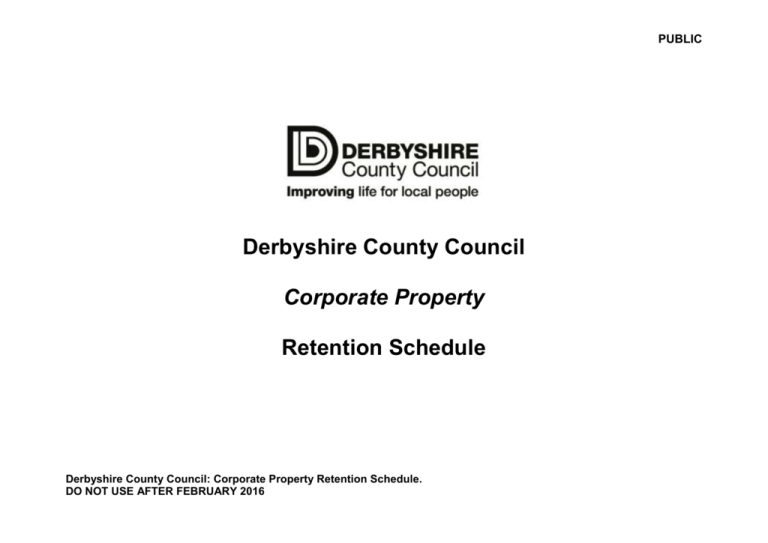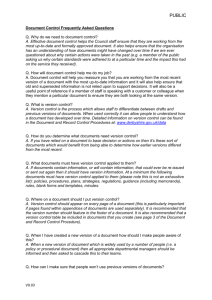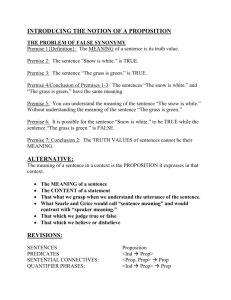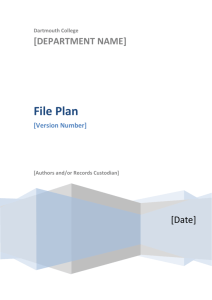Corporate Property retention schedule
advertisement

PUBLIC Derbyshire County Council Corporate Property Retention Schedule Derbyshire County Council: Corporate Property Retention Schedule. DO NOT USE AFTER FEBRUARY 2016 PUBLIC Derbyshire County Council: Corporate Property Retention Schedule. DO NOT USE AFTER FEBRUARY 2016 Approval Sources and Ownership Section Date Detail Version History Version Date 1.00 2006 2.00 February 2014 Detail First version Second version – restructured and revised 2 Owner Authorising Officer Author Alan Beastall Andrew Rowan Approval Officer Alan Beastall Jeremy Goacher Derbyshire County Council: Corporate Property Retention Schedule. DO NOT USE AFTER FEBRUARY 2016 PUBLIC Introduction The ongoing development of retention schedules is part of the commitment to good record keeping under the Authority’s Corporate Records Management Policy. It provides consistent guidance on how long records within [name of department] should be retained. In some situations the length of time the records are retained may vary due to the specific circumstances relating to the documents concerned, in particular the integrity of records which pre-date this guidance cannot be assured. In addition to the time periods specified, the Data Protection/Freedom of Information Officer and Corporate Records Manager will continue to liaise with and advise colleagues in relation to their record keeping requirements. Retention periods have been assigned after consideration of legal requirements, good practice guidance and the business needs of the Department. The Schedule is designed to ensure that information is kept as long as necessary, whilst addressing compliance with the Data Protection Act 1998.The retention periods within the schedule apply to information in all formats and should be applied consistently regardless of whether the information is held manually or electronically. When storing information in electronic format, only approved applications should be used to ensure long-term accessibility of information. Any records containing personal data or confidential information (i.e. a record containing basic personal data, such as name, address, contact details, date of birth or similar) should be disposed of in accordance with the Authority’s guidance on disposing of confidential waste (see Records Disposal Policy: www.derbyshire.gov.uk/data). When retention periods for records have expired documents should be reviewed in accordance with this guidance, with a view to disposal. If it is believed that there is justification to retain the data for longer, the Departmental Data Protection/Freedom of Information Officer and Corporate Records Manager must be expressly involved in that decision. 3 Derbyshire County Council: Corporate Property Retention Schedule. DO NOT USE AFTER FEBRUARY 2016 PUBLIC Standard Operating Procedures Some records do not need to be kept at all. Standard Operating Procedures (SOP) define all records which staff may routinely destroy in the normal course of business. However, the retention/disposal schedule must still contain references and instructions concerning them. SOP usually applies to information that is duplicated, unimportant, or of only short term transactional or operational value. Examples include: ‘with compliments’ slips catalogues and trade journals reports from third parties circulated for information journals of professional bodies or organisations Telephone message slips non-acceptance of invitations trivial electronic mail messages or notes that are not related to Authority business requests for standard information such as location maps, plans, contact details, opening hours or promotional material out-of-date distribution lists/staff directories minutes circulated for information (Note, this is not an exhaustive list) Duplicated and superseded material such as official stationery, manuals, drafts, forms, address books and reference copies of DCC annual reports may be destroyed under SOP. Electronic copies of documents where a hard copy has been printed and filed, and thermal paper facsimiles after making and filing a photocopy, are also covered by SOP and may be destroyed SOP should not be applied to records or information that can be used as evidence– to prove that something happened or that a decision was reached. Examples include: staff meeting minutes, public consultation papers or any record that has made a significant contribution to the discussion of the business being conducted should be captured as a record and have a retention period assigned. 4 Derbyshire County Council: Corporate Property Retention Schedule. DO NOT USE AFTER FEBRUARY 2016 PUBLIC Glossary of Terms: Closure: when a record ceases to be ‘current’ – this can be the when a set of minutes are formally agreed, or when a Help Desk incident is formally closed. Many retention periods are triggered after the ‘closure’ of a record Disposal: the processes associated with the end of a records lifecycle, they will typically include destruction of the records or transfer of the records to Derbyshire Record Office for permanent preservation Functional Description: the description of the function that the record serves (i.e. the functional description of a set of minutes is ‘the process of preparing business…’) Permanent: Retain the record permanently and transfer to Derbyshire Record Office Record: the recorded evidence about an activity Retention Action: the action regarding the retention of a record, these will be triggered by a particular event (i.e. the closure of a record) For further information regarding this retention schedule, orr records management generally, please contact the Council’s Records Management Section at records.management@derbyshire.gov.uk or on ext. 39203 5 PUBLIC Derbyshire County Council: Corporate Property Retention Schedule. DO NOT USE AFTER FEBRUARY 2016 Ref. No. Functional Description 1 PROP 1.1 PROP 1.2 Retention Action Examples of Records Notes Maintenance of council property The process of ensuring the regular maintenance of council property 7 years from last action 7 years from last action The process of undertaken planned and responsible maintenance of council property PROP 1.3 The process of undertaking refurbishment of council properties 7 years from completion of works PROP 1.4 2 The process of scheduling and planning maintenance works Property Acquisition and Disposal 3 years from closure Business Requirement PROP 2.1 The process of acquiring council property Destroy 12 years from closure Limitations Act 1980 PROP 2.2 The process of negotiating land purchases Destroy 12 years from closure Limitations Act 1980 PROP 2.3 The process of leasing council property Destroy 6 years from termination of lease Limitations Act 1980 6 PUBLIC Derbyshire County Council: Corporate Property Retention Schedule. DO NOT USE AFTER FEBRUARY 2016 Ref. No. Functional Description Retention Action PROP 2.4 The process of valuing property Destroy 12 years from closure Limitations Act 1980 PROP 2.5 The process of resolving claims arising from property acquisitions Destroy 6 years from resolution Limitations Act 1980 PROP 2.6 3 The process of disposing of council property Property and land management Destroy 12 years from date of disposal Limitations Act 1980 PROP 3.1 The process of managing access to council property Destroy 6 years from closure The Equalities Act 2010 PROP 3.2 The process of surveying council properties Destroy 12 years from closure Limitations Act 1980 PROP 3.3 The process of managing the distribution and allocation of council properties Destroy 6 years from closure Business Requirement PROP 3.4 The process of managing the energy usage relating to council properties Destroy 10 years from closure The Energy Performance of Buildings Regulations 2012 PROP 3.5 The process of disposing of council equipment Destroy 6 years from date of disposal Limitations Act 1980 PROP 3.6 The process of managing council facilities (i.e. cleaners) Destroy 6 years from closure Limitations Act 1980 PROP 3.7 The process of checking the feasibility of council properties Review 6 years from closure Business Requirement 7 Examples of Records Notes PUBLIC Derbyshire County Council: Corporate Property Retention Schedule. DO NOT USE AFTER FEBRUARY 2016 Ref. No. Functional Description Retention Action PROP 3.8 The process of reaching internal agreements concerning council property Destroy 6 years from closure Limitations Act 1980 PROP 3.9 The process of developing and using maps and providing directions Destroy 2 years from superseded Business Requirement PROP 3.10 The process of managing the provision of council property services Destroy 6 years from closure Business Requirement PROP 3.11 The process of managing a property review and replacement programme Review 6 years from closure Business Requirement PROP 3.12 The process of developing inventories for properties and assets Destroy 6 years from closure Business Requirement PROP 3.13 The process of managing the security of council properties Destroy 6 years from closure Business Requirement PROP 3.14 4 The process of managing and responding to queries regarding ownership of land Property Development and Renovation Review 10 years from closure Countryside and Rights of Way Act 2000 PROP 4.1 The process of managing the development and renovation of an existing council property Destroy 6 years from sale of building Business Requirement PROP 4.2 The process of developing properties for council clients Destroy 7 years from closure Chronically Sick and Disabled Persons Act PROP 4.3 The process of developing properties for external organisations Destroy 7 years from closure The Limitations Act 1980 8 Examples of Records Notes PUBLIC Derbyshire County Council: Corporate Property Retention Schedule. DO NOT USE AFTER FEBRUARY 2016 Ref. No. Functional Description Retention Action PROP 4.4 The process of raising a work order relating to property development and renovation Destroy 7 years from closure Accounts and Audit Regulations 2003 PROP 4.5 5 The process of designing properties Leasing and Occupancy Destroy 12 years from closure The Limitations Act 1980 PROP 5.1 The process of administering leased property Destroy 6 years from end of lease The Limitations Act 1980 9 Examples of Records Notes





